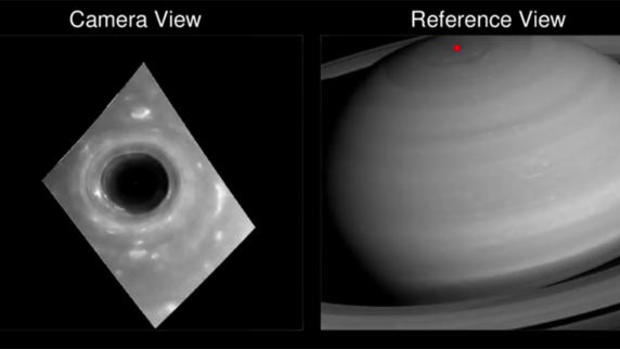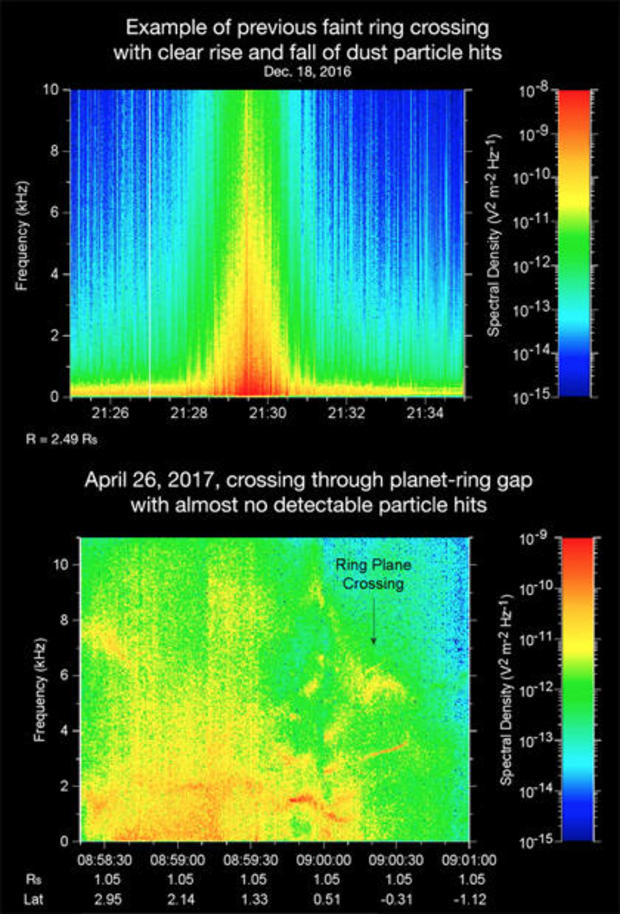Cassini completes second pass inside Saturn's rings
NASA's Cassini probe survived its second pass between Saturn and its innermost rings earlier this week, giving scientists increasing confidence the region between the rings and the cloud tops is clear of large particles that might represent a threat to the spacecraft.
Virtually out of propellant, Cassini is wrapping up its extended 13-year mission at Saturn by making 22 dives between the gas giant and its vast ring system, collecting priceless science data before crashing into the planet in September in a long-planned kamikaze-like maneuver to close out a remarkably successful flight.
On April 26, Cassini made the first of 22 planned ring-plane crossings, using its large dish antenna as a shield in case scientists had underestimated the amount of ring material that might be present. Crossing the plane at more than 76,000 mph, even relatively small particles could cause serious damage.
After the first passage, data collected by Cassini showed very few detectable particles, giving researchers confidence the spacecraft will make it all the way through its "Grand Finale" end game.
The spacecraft made its second ring-plane crossing Tuesday, and phoned home the following day as expected.
"The big surprise, we were expecting the ring particles would taper off very slowly as you go toward Saturn and to find a region where there are essentially no ring particles is a huge puzzle," said Linda Spilker, the Cassini project scientist at NASA's Jet Propulsion Laboratory in Pasadena, Calif.
"It really looks like it's pretty much clear at the radius we flew through. ... We expected (particle density) to be down a little bit. But basically, it's clear. The big question is, these ring particles, where did they go? What process basically has cleared the region that we flew through? It's a puzzle."
One of the major objectives of Cassini's Grand Finale is to measure the mass of Saturn's rings by studying how the spacecraft's trajectory was affected by Saturn's gravity when the spacecraft was just outside and then inside the rings. The effects of the ring material alone can then be subtracted out, in a sense, to determine the mass.
NASA released a dramatic movie Wednesday made up of stills shot by Cassini's camera as it sailed over Saturn's north pole and descended toward the first ring plane crossing on April 26.
When the movie begins, Cassini was 45,000 miles above Saturn's polar clouds. By the time it ends, the spacecraft's altitude was down to 4,200 miles as it approached the plane of the rings. At close approach, the spacecraft was just 1,900 miles from Saturn's cloud tops and just 200 or so from the inner boundary of the rings.
Because of Cassini's extreme speed as it neared the ring plane crossing, the imaging team opted to forego color and to make short exposures to minimize blurring.
Representing one hour of travel, the movie shows the huge cyclone-like storm at Saturn's north pole that is at the center of a giant hexagon pattern in the planet's northern atmosphere. Scientists expect the observations to shed light on what keeps the hexagon stable, how deep the storms extended and what drives them.
"The images from the first pass were great, but we were conservative with the camera settings," Andrew Ingersoll, an expert on gas giant atmospheres and a member of the Cassini imaging team, said in a statement.
"We plan to make updates to our observations for a similar opportunity on June 28 that we think will result in even better views," he added.
The third of the planned 22 ring plane crossings is expected on May 9.






